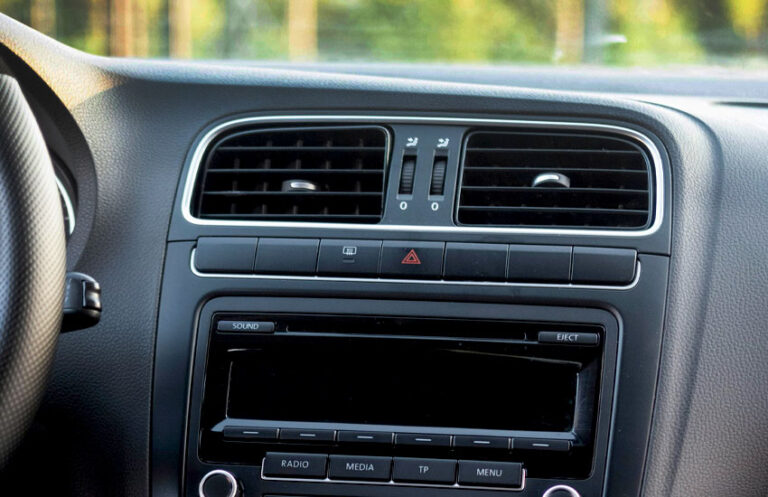As an Amazon Associate, I earn from qualifying purchases at no extra cost to you.
Cruise Control Not Working? Here’s How To Fix It Easily!
You turn on your cruise control, but nothing happens. It's frustrating, right? I've been there too, driving down a long highway, excited to rest my foot, but the cruise control just wouldn't work. The good news is — it's usually not too hard to fix.
The most common causes are a blown fuse, brake light switch issue, or a bad sensor. In this article, I'll walk you through everything step-by-step, using very easy words. You'll learn how to find the problem and fix it fast.
Check the Cruise Control Fuse First
If your cruise control is not working, one of the easiest things to check first is the fuse. The fuse is a tiny part in your car's fuse box that protects the cruise control system from power problems. When a fuse blows, it breaks the electric connection, and the cruise control can't turn on at all.
To find the fuse box, check your car's manual. It is often located under the dashboard, under the hood, or near the side of the dashboard when you open the driver's door. Look for a diagram inside the fuse box cover or in the manual. Find the one that says something like ‘Cruise Control’, ‘CC’, or ‘ECM’.
Once you find the cruise control fuse, gently pull it out using a fuse puller or even tweezers. Hold it up to the light. If the tiny wire inside is broken or burned, the fuse is bad. You need to replace it with a new one that has the exact same number (for example, 10A or 15A).
Buy the same size and type of fuse from an auto parts store. Push the new one back into the same spot. Close the fuse box and test your cruise control. In many cases, this easy fix brings it back to life!
But if the fuse keeps blowing again and again, there might be a deeper problem in the wiring or another cruise control part. You will need a mechanic to help check that.
- Locate the fuse box in your car.
- Find the cruise control fuse in the diagram.
- Remove and inspect the fuse.
- Replace it if it looks burned or broken.
- Use the same amp number for the new fuse.
- If the new fuse also blows, get a mechanic's help.
Inspect the Brake Pedal and Brake Light Switch
Cruise control is connected to your brake system. It needs to turn off when you hit the brake pedal. This is for safety. That's why your car has a small switch near the top of the brake pedal. This switch tells the car when the brake is pressed.
If this switch is broken or not adjusted right, your car might think the brake is always being pressed. And if the car thinks you are braking, it will not let the cruise control turn on.
Look under your dashboard near the brake pedal. You'll see a small switch that touches the top of the brake pedal arm. This is the brake light switch. When you press the brake, the arm moves, and the switch tells your car to turn on the brake lights and also turn off cruise control.
If your brake lights are always on or never come on, the switch might be stuck or faulty. You can try adjusting it. The switch usually screws in or out, so you can move it a little to get it working again.
If adjusting doesn't help, you may need a new brake light switch. It's not very expensive and easy to replace in most cars. Unplug the wire from the old switch, unscrew it, and put the new one in.
Also, check the brake pedal for anything stuck under it, like a mat or debris. That can also make the system think the brake is being pressed.
- Cruise control shuts off when brake is pressed.
- Brake light switch tells the system when braking.
- Check if brake lights stay on or never light up.
- Adjust or replace the brake light switch if needed.
- Check the floor mat or anything under the pedal.
- Replace the switch if it’s old or broken.
Look at the Speed Sensor
The speed sensor is like the eyes of the cruise control system. It tells the car how fast you are driving. If this sensor stops working, the cruise control cannot hold a steady speed because it doesn't know your speed.
The speed sensor is usually located on the transmission. When this sensor goes bad, you may also notice problems with your speedometer or transmission shifting. If your cruise control stopped working and your speedometer is acting strange, the sensor might be the reason.
Sometimes the speed sensor just gets dirty or covered with grease or dust. You can try cleaning it with a soft cloth. Make sure your car is turned off and cool before doing this.
To replace the speed sensor, you may need to jack up your car and remove a few bolts. It’s not too hard if you are careful. You can also ask a mechanic to test it and replace it if needed.
Some modern cars have more than one speed sensor, so it's a good idea to check the repair manual or ask an expert to find the exact one for cruise control.
- Speed sensor gives speed data to cruise control.
- Bad sensor can cause cruise to stop working.
- Check if speedometer is also not working right.
- Clean the sensor gently if dirty.
- Replace it if it's not sending the correct signal.
- Ask mechanic for help with testing or replacing.
Check the Cruise Control Switch and Buttons
The cruise control switch or buttons are what you use to turn the system on and set the speed. These can wear out over time, especially if you use them often. Also, if the wiring inside the steering wheel gets damaged, it can stop the cruise from working.
The buttons are usually on the steering wheel or a stalk near it. Try pressing them. Do they feel loose or not click like before? If they feel different, they might be broken. Also check if the cruise control light comes on the dashboard when you press the ON button. If not, the system is not getting power from the switch.
Another thing to check is the clock spring. This is a part inside the steering wheel that helps connect the buttons to the car’s computer. If your horn or airbag light also stopped working, the clock spring might be broken.
You may need to remove the steering wheel to check or replace the buttons or clock spring. This is a bit more difficult, and you should disconnect the battery first to avoid any airbag issues.
If you’re not sure how to do this, a mechanic can test the switch and clock spring for you.
- Cruise control switch sends signals to the system.
- Broken buttons won't activate the cruise system.
- No cruise light on dashboard may mean switch problem.
- Worn clock spring can stop button signals.
- Test buttons and look for signs of wear or damage.
- Let a mechanic handle steering wheel parts if needed.
Inspect the Throttle and Vacuum System
In older cars, cruise control uses vacuum lines to control the throttle. In newer cars, it's done electronically. If there's a problem with the throttle body or vacuum lines, the cruise won't work.
First, check under the hood for any loose, cracked, or broken vacuum hoses. These are small rubber tubes that connect to different parts of the engine. If one is broken, the cruise control may not get the power it needs.
Next, look at the throttle body. This is what controls how much air goes into your engine. Dirt, grease, or carbon buildup can make it stick. You can clean the throttle body using a throttle body cleaner and a cloth. Make sure the engine is off and cool.
If your car has an electronic throttle, a sensor inside it may be bad. This can stop the cruise control from working. You may need a mechanic to scan for error codes to find the issue.
Also, check for any check engine lights. These lights often point to problems with sensors or air systems that affect cruise control.
- Older cars use vacuum lines for cruise control.
- Broken hoses can stop cruise system.
- Clean the throttle body if dirty or sticky.
- Electronic throttle problems can stop cruise.
- Use a scanner to check for error codes.
- Look under the hood for hose damage or leaks.
Test the Cruise Control Module or ECU
The cruise control system has its own control module or uses the car's main computer (called ECU). If all other parts seem fine but cruise still doesn’t work, the module may be the problem.
Sometimes, the cruise module just needs to be reset. You can try disconnecting the car battery for 10 minutes. This clears memory and may fix the issue. But be careful: this also resets other settings like the radio and clock.
Other times, the module itself is damaged or not getting power. It can happen due to water leaks, corrosion, or wiring problems. If your car had a battery change or electrical issue recently, it might have caused the problem.
The cruise control module is often hidden behind the dashboard or near the engine. You may need a mechanic to test it with special tools.
In some cases, updating the software in the ECU can fix cruise control problems. Dealerships can do this with a computer tool.
If you changed the steering wheel, instrument cluster, or added aftermarket parts, it may confuse the module. So check if any changes were made before the issue started.
- Cruise control module manages all cruise functions.
- It can stop working after electrical issues.
- Try resetting it by disconnecting the battery.
- Look for signs of water damage or bad wiring.
- Ask a mechanic to test or replace the module.
- Software update may also fix the system.
- Check fuse box and replace burned cruise control fuse
- Inspect brake switch and lights; adjust or replace if needed
- Look at speed sensor; clean or change it if not working
- Test steering wheel cruise buttons and check for clock spring issues
- Clean throttle body and inspect vacuum lines
- Reset or repair cruise control module or ECU
Quick Guide Table
| Problem Area | What To Check | What To Do |
|---|---|---|
| Fuse | Look for burned fuse | Replace with same amp fuse |
| Brake Light Switch | Test if brake lights stay on/off | Adjust or replace the switch |
| Speed Sensor | Check speedometer and sensor signals | Clean or change the sensor |
| Cruise Buttons | Test buttons and dashboard light | Replace buttons or clock spring |
| Throttle or Vacuum | Check hoses and clean throttle body | Repair hose or clean throttle |
| Cruise Module or ECU | Check for water damage or error codes | Reset battery or repair module |
Final Thoughts
Having your cruise control not working can be really annoying, especially on long drives. But the good part is, many of the causes are easy to fix. You just need to take your time and check each area one by one. Start with the simple things like the fuse and brake switch. Then move on to the sensors and modules if needed. In many cases, you don't even need a mechanic. Fixing it yourself can save time and money — and bring your smooth driving back again!
Frequently Asked Questions (FAQs)
Is it safe to drive if my cruise control is not working?
Yes, it is safe to drive without cruise control. Cruise control is a comfort feature, not a safety one. Your car will still drive just fine without it. But if cruise control suddenly stopped working along with other signs like strange engine lights or brake lights not working, it may be a sign of a bigger problem. In that case, it's better to have it checked. Driving with a faulty brake switch or broken throttle sensor can cause other issues too. Always fix cruise control problems as soon as you can.
Can a dead battery affect cruise control?
Yes, a dead or weak battery can affect cruise control. If your car's battery recently died or was replaced, the cruise control memory might have reset. Some systems need to relearn settings or may need a software update. Also, if the battery is weak, the system might shut off non-essential functions like cruise control. Always check your battery voltage and connections if you notice electrical problems in your car.
Do I need a mechanic to fix cruise control?
Not always. Many cruise control problems can be fixed at home if you follow the right steps. Checking and changing the fuse, brake switch, or cleaning sensors is easy. But for deeper problems like the ECU or steering wheel wiring, a mechanic might be needed. If you don't feel confident, it's okay to ask for help. Fixing it the right way is better than guessing and making it worse.
Is it expensive to repair cruise control?
The cost depends on the problem. Replacing a fuse or switch can cost just a few dollars. But if the control module or sensors are broken, it may cost more. Labor charges from a mechanic also add to the cost. On average, simple fixes cost under $50, while complex ones may go up to $300. Always try to find the exact problem first, so you don't spend money on parts you don't need.
Can cruise control stop working after a brake job?
Yes, sometimes after brake repairs, the cruise control may stop working. This can happen if the brake light switch was moved or disconnected during the job. If the switch is not adjusted right, the system may think you are always pressing the brake, and that turns off cruise control. Always check the brake switch after a brake repair. It's a small part but very important for the cruise system.
Do I need to reset anything after fixing cruise control?
Sometimes, yes. If you change parts like the speed sensor or cruise module, you may need to reset the system. This can be done by disconnecting the battery for a few minutes. Some cars may need a scanner tool to clear error codes. If the system doesn't work right after fixing, try a reset before doing anything else. That may be all it needs.
Is it possible to upgrade old cruise control to new type?
Yes, in many cars you can upgrade the cruise control system. For example, from vacuum-based to electronic cruise control. This may need new parts like throttle controllers, modules, and wiring. But it's not always easy or cheap. Some people also install aftermarket cruise systems in older cars. If you want to upgrade, talk to a mechanic or shop that does custom installs. They can tell you what works for your car.
Can weather affect cruise control?
Yes, very hot or very cold weather can sometimes affect cruise control. In cold weather, sensors might freeze or wires may shrink, causing poor connections. In very hot weather, plastic parts can melt or wires may get loose. Also, rain or water leaks can damage the cruise control module or wiring. If cruise control stops working after extreme weather, let the car dry out and then test again.






